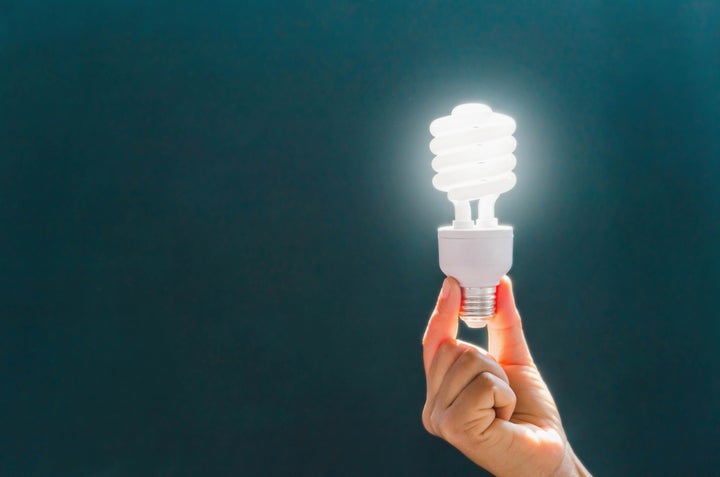It’s one thing to want to save energy - and another to know how to actually do it. There’s a lot of mixed messages out there, with regards to staying eco (a March 2018 survey showed that, while eight out of 10 British people believe that recycling makes a difference, no one out of the 2,000 people questioned scored full marks on a quiz on the subject. Meanwhile, a May 2018 survey found that 60% of us are confused about our electricity and gas bills.)
We spoke with some energy experts to debunk a handful of the biggest energy-saving myths you might believe - but definitely shouldn’t.

LED bulbs are too expensive
“LEDs have reduced in price hugely over the years,” says Pippa Box from Anthesis Group, a sustainability consultancy. “It’s true that they are marginally more expensive than compact fluorescent or halogen, but only at the point of sale. Over their lifetime they will save many times more the additional cost. For example, a halogen spotlight in your ceiling will probably be consuming 50 watts, whereas an LED replacement will consume five watts. The LED bulb might cost £5 to buy, but, over a year, will only cost £1.28 to run compared to £12.80 for a halogen bulb (assuming a 14p pence per kWh unit price and that, over the year, the bulb is used for five hours a day on average).
“Finally, LEDs have a lifetime of 50,000 hours compared to only 1,000 hours for a halogen. So really, which bulb is more expensive? Not the LED.”
It’s cheaper to run appliances at night
This is only true if you’re on a specific economy 7 or 10 tariff (the former involves paying less for energy over a seven hour time span, in which you’re likely to use the least energy - so you might have an ‘off peak’ period from 12am-7am, while the latter involves a more variable ‘off peak,’ such as five hours at night and another couple during the day.)
Otherwise, if you’re on another tariff, it won’t make a difference.

It’s cheaper to use a small, electric heater than a radiator
Electric heaters are one of the most expensive forms of heating. Generally, the cheapest way is using an efficient gas central heating system, with a full set of thermostatic radiator valves, a room thermostat and a timer.
As to any extra actions to take?
“Close your curtains at night. This may sound really simple but heat escapes a lot faster if curtains aren’t drawn,” suggests Jon Ostler, energy expert and CEO of comparison site Finder.com.
Box adds: “To improve the operation of radiators and help them keep you warm, make sure no furniture or curtains are blocking the radiator from the room, keep the fins free of dust and use a radiator reflector behind the radiator.”
Putting fewer clothes in the washing machine saves energy
Full loads - whether it be a tumble dryer, washing machine or dishwasher - will always use less energy, as two half loads will use more energy than a single full one.
Leaving the heating or hot water on constantly uses less energy than controlling it on a timer
There is a common misconception that the initial energy required to turn something on is more than the energy required to run it for a few hours and that, therefore, turning it on and off uses more energy than leaving the item running.
This is not the case. If your heating is on, it’s using more energy than if it were off, as having the temperature higher in your home means more heat is being lost to outside. The energy used to warm up your home after the heating has been off for a few hours is less than would have been used keeping it warm.
Imagine boiling an egg for breakfast in a pan, then boiling that same pan of water in the evening. This uses much less energy than heating the pan all day. So, it’s crucial to set your heating and hot water timers to run for the least amount of time possible - an hour or two before you arrive home/wakeup, until an hour or two before you leave/go to bed is about right.

Switching energy suppliers is too much hassle
“A simple misconception - that is still surprisingly widespread - is that switching energy suppliers is difficult or time consuming,” says Ostler. “Our research found that a quarter (24%) of Brits can’t be bothered to switch or don’t feel they have the time to do so. When you consider that you can complete a switch online in under 15 minutes and potentially save £300 a year, it seems crazy not to do so.”
If it’s cold, you should turn your thermostatic radiator valve setting up to maximum
The thermostatic radiator valve (TRV) is a device for turning the radiator on or off depending on the temperature of the space around it. The setting on the TRV determines what temperature you want to heat the space to. It is recommended to set your TRV to ‘3,’ in order to achieve 18-20 degrees. This means that once a temperature of 20 degrees is reached in the room, the TRV turns off the radiator.
Setting the TRV to ‘4’ means the radiator is switched off at 20-22 degrees, and setting it to ‘5’ means that the TRV will not turn the radiator off, no matter how warm the space. So, if you’re cold, make small adjustments to the TRV, say, up by ‘0.5,’ and reassess in an hour or two.
Large adjustments such as turning the TRV up to ‘5’ will not speed up how fast the room warms up - it will only mean that the TRV does not turn off the radiator at the temperature you are comfortable with. Hey presto, the room will overheat and you’ll waste energy.